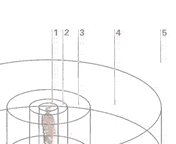
I met these guys at Banff years ago at an Interactive Screen (back in Sara Diamond daze)… Artists are in the fortunate position to plumb the relations between technology and society, technology and culture, concept, and so on. Make me jealous. Blast theory were doing VR wargame stuff, and had become notorious for a kidnapping they held in London (i think) for which they sold raffle tix! The hostage was held in a wooden box and broadcast online via webcam… It was the inverse of reality tv: a common citizen volunteering to be kidnapped for the sake of art, and publicized as that art.
I grabbed these quotes from Nick’s project on cell phones and social relations. It captures the difficulty of mapping the interplay of technology, social relations, and concepts of society/social reproduction. We often pull out communication technology as something special. Similar to architecture, say, but different its dynamics. Technologies are objects, but they’re not dumb, static, and stable. They’re conduits and mediators. And when they’re mobile, it seems that they lift us even further out of our social fabric. But interpersonal connections, social relations, and relationships involve what we call “meaning.” In sociology, meaning occupies a particular place: it’s not a thing. It’s a binding. And when it’s produced out of talk, it combines linguistic meanings as well as interpersonal relations (the I’m OK, You’re OK stuff).
Technologies are as much a part of our cities as our buildings. Networks, wired or wireless, matter as much as the matter they span and the matters they handle… But technologies are not architecture, and social relations are not spatial (the misnomer “social space”). If the hard stuff is first order technology and interaction, the soft stuff is second order effect. Where the former involves a user interface, the latter involves a social interface. When we go from users to social practices we lose access to the building materials we’re used to. I’d like to see more on temporality, and how devices like the mobile phone transform experience along the temporal axis: the asynchronicity of text/sms vs talk; the effect of distractions, interruptions, and fragmentation of continuity. More, too, on presence negotiation — how we manage others’ access to us, expectations of our availability, and of course the ambiguity of absence and silence, delays, and waiting… Here, too, presence involves time as much as it does space. Note, too, that space is not place. Sociologist Anthony Giddens is good on this: place and location are marked by social/cultural meanings; space is empty.
This is tough stuff, and I don’t think it’s adequately covered in design programs, but it’s the critical dimension, and so as long as it’s where we’re itchy we might as well scratch.
Wouldn’t it be fun to work on an art project?
From Mutual Friend:
“Increased mobility has brought about an increasingly disjointed relationship to physical and social space. The transit from home to driveway > car > side street > bypass > industrial estate to workplace and back can be sparsely populated. Public spaces are more likely to be areas of transit, weariness and solitude than of easy sociability, participation, frankness and debate.
The mobile phone has had an ambiguous role in these spaces, at once, providing a means to feel safe and talk to friends, while disrupting your attachment to those around you.”
From Mutual Friend’s workshop ideas http://www.amutualfriend.co.uk/html/workshop/workshop_intro_ideas.html
“These are some odd questions and ideas that have been part of our thinking in developing this work.
How does the geography of a city relate to someone’s experience in it?
What are the important structures and landmarks of the city?
How can a meaningful narrative be generated by mapping someone’s route?
Physical Spaces:
– its arrangements of living & working spaces
– forms of transport
– layouts of buildings and provision of public spaces
Virtual/electronic & media spaces made visible through:
– public electronic interfaces & billboards
– mobile devices and networks
– personal computers at home & work
– phones and mobile phones
Social Spaces:
– what networks of communication are sustained?
– what rules & social codes are attached to particular locations?
– what are the stories and key characters that inform how people experience public space?”
